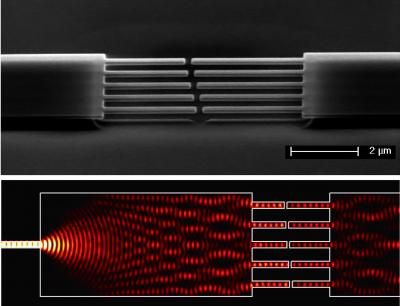Researchers Observe Superradiance in a Free Electron Laser
Technique paves way for generating ultra-short pulses in future light sources
At the U.S. Department of Energy's (DOE) Brookhaven National Laboratory, a team of researchers has generated extremely short light pulses using a new technique that could be used in the next generation of light source facilities around the world to catch molecules and atoms in action. Published in Physical Review Letters, the research team's findings describe the use of a laser to control the pulse duration of light from a free electron laser (FEL), a type of light source with a brightness up to one billion times higher than that of ordinary synchrotron light. The team also reports the first experimental observation of a phenomenon called superradiance.
Most of the world's light sources - facilities such as Brookhaven's National Synchrotron Light Source (NSLS) that produce x-ray, ultraviolet, and infrared light for research in fields ranging from biology to nanotechnology - produce a broad range of wavelengths, or colors of light. This is ideal for hosting a wide variety of experiments, but to understand how molecules change their structure in chemical and biological systems, scientists need extremely short pulses of light (shorter than one trillionth of a second) with short wavelengths. This is where FELs are valuable, as they can provide pulses of light that are a thousand times shorter than those produced at existing light sources and contain a million more photons per pulse. Like a strobe flash, the ultra-short FEL allows scientists to take time-resolved images of biological and chemical processes and various other atomic-scale events.
"In existing light sources, we just take a static snapshot of a sample," said NSLS physicist Takahiro Watanabe, one of the paper's authors. "We get the location of the pieces, but what happens if the pieces move? You don't know how they actually got there. What you want is to take images along the way to see these things move, and that's where these ultra-fast sources come into play."
At Brookhaven's Source Development Lab (SDL), researchers found a way to generate a very short FEL pulse that doesn't depend on the length of the electron pulse. This was done using a titanium-sapphire laser that combines a femtoseconds pulse of light with the much longer electron beam. A femtosecond is extremely fast - one billionth of one millionth of a second. This leads to a femtosecond FEL pulse that keeps growing in intensity and shortening in time duration, which is attributed to a phenomenon called superradiance.
Superradiance was first proposed in 1954 as the most efficient way to extract energy from either atomic or molecular systems, but the SDL research group is the first to experimentally observe its effects in this type of FEL setup. Understanding how to produce these intense, ultrafast pulses of light could help scientists around the world as they begin to construct the next generation of light source facilities.
Most read news
Organizations
Other news from the department science

Get the analytics and lab tech industry in your inbox
By submitting this form you agree that LUMITOS AG will send you the newsletter(s) selected above by email. Your data will not be passed on to third parties. Your data will be stored and processed in accordance with our data protection regulations. LUMITOS may contact you by email for the purpose of advertising or market and opinion surveys. You can revoke your consent at any time without giving reasons to LUMITOS AG, Ernst-Augustin-Str. 2, 12489 Berlin, Germany or by e-mail at revoke@lumitos.com with effect for the future. In addition, each email contains a link to unsubscribe from the corresponding newsletter.






















































